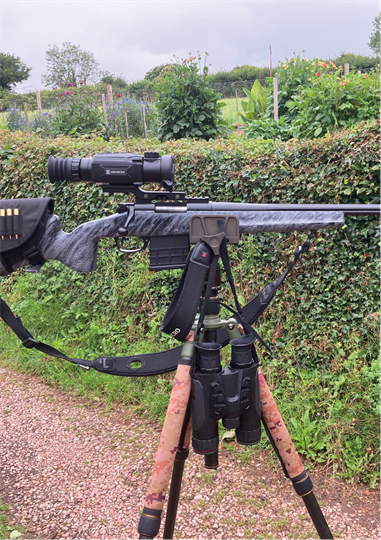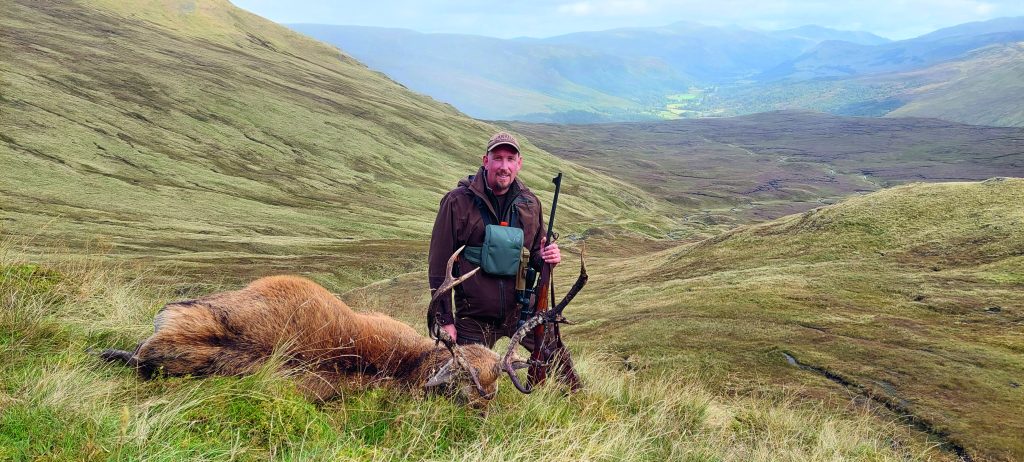DOUBLE TROUBLE
Mike Powell has to deal with two foxes that have learned to jump the electric fence around a chicken house – a rare but problematic skill among these predators.

Earlier this year, I wrote about two foxes that independently carried out simultaneous raids on the same evening at the local chicken farm, causing substantial damage. I was able to resolve the problem quickly, and for a while, no further attacks were reported. However, at the start of June, another local farmer—who keeps a couple of hundred birds to supply his farm shop with eggs—phoned to say he was losing about one bird a night.
Following the call, I visited the farm, which is located at the other end of the village, and inspected the chicken house and run. It soon became clear that this was the work of the worst kind of chicken thief—a fox that had breached the run itself. It’s troubling enough when a bird that flies over the electric netting is taken, but when a fox realises it can jump the fence, you’re in serious trouble. Fortunately, most don’t learn this trick. The farmer’s current flock was nearing the end of its useful life and would be replaced in a couple of weeks. However, if left unchecked, the fox would undoubtedly turn its attention to the new arrivals. Action needed to be taken immediately.
I waited out for two nights, but the fox didn’t appear. On the third night, another raid occurred, so that evening I set up once more, hoping the fox would return to collect one of the birds it had already killed. Around 7:30 p.m., I erected a quick hide with camo netting and settled in to wait. Three hours later, using the excellent Hik Habrok thermal binoculars, I spotted a fox approaching through the hedge behind the poultry house. The grass was tall, and although the thermal optics easily picked out the fox, my night vision couldn’t.
Time passed as the fox searched around the far side of the run. Eventually, it worked its way along the netting, looking for a spot to jump over. A bare patch of ground below the pen offered a likely entry point, and sure enough, the fox arrived there. Through the Pard 007SP, I could clearly see it staring at the netting, preparing to jump. However, a .243 75gr bullet interrupted its plans, and the jump was never made. After 15 hours of waiting in total, I was pleased to have resolved the issue, or so I thought.
The following morning, I reported back to the farmer, believing the problem had been solved. Unfortunately, it hadn’t. Three days later, I received another call—the attacks had continued. I was confident the fox I’d shot was one of the culprits, but clearly, another was at work. Knowing the ground well, I followed the same procedure, suspecting the second predator would approach from the same direction.
I set up early in the evening, as foxes often hunt during daylight at this time of year. By 7:30 p.m., the camo was in place, and I settled in for what I hoped would be a short wait. As the long summer evening drew to a close, I decided to call it a night by 11:00 p.m. if the fox didn’t show. Just as I was preparing to leave, a couple of rabbits that had been keeping me entertained suddenly sat bolt upright in their characteristic “look out, there’s a fox about” pose.
Anyone who shoots foxes from a static position knows that rabbits are excellent early warning systems, and their behaviour rarely fails to signal a fox in the vicinity. Sure enough, a few minutes later, the thermal binoculars picked up a fox entering the field via the same run as the first one I’d shot. This fox was more confident, moving along the netting without hesitation.
Through the Pard, I tracked its eye shine and waited until it reached a spot where it was clearly visible. When it turned broadside, a shout stopped it in its tracks. The Sako A2 sent a 75gr bullet its way, and at just under 100 yards, the fox dropped instantly. After three and a half hours of standing in one position, I was more than ready to head home.
The next morning, I returned to retrieve the carcass and was surprised to find not only the dead fox but also a chicken it had killed previously. The chicken must have been dead for some time, as it emitted no heat signature the night before. Since then, there have been no further attacks, and the new birds are settling in well.
Although foxes are capable of jumping a 4ft electric fence, few learn how to do so. That said, I was surprised these two foxes had mastered the technique. It reminded me of a raid on this same farm a couple of years ago when a vixen and her three well-grown cubs were seen jumping into a run while the cubs watched. I suspect the two foxes I recently dealt with were among those cubs, having learned the trick from their mother.
Foxes like this must be dealt with, as they can cause significant financial and psychological harm. They don’t understand they’re doing wrong; they’re simply trying to survive. Thankfully, most foxes don’t cause problems and can go about their lives undisturbed—until they cross the line.
Since this report, there have been additional raids on chicken setups around the village. I’ve shot six more foxes in the act, including a relatively young cub. I suspect many of these predators are coming from neighbouring RSPB land, where I was stopped from shooting several years ago. Still, it keeps me busy.
Related Articles
Get the latest news delivered direct to your door
Subscribe to Rifle Shooter
Elevate your shooting experience with a subscription to Rifle Shooter magazine, the UK’s premier publication for dedicated rifle enthusiasts.
Whether you’re a seasoned shot or new to the sport, Rifle Shooter delivers expert insights, in-depth gear reviews and invaluable techniques to enhance your skills. Each bi-monthly issue brings you the latest in deer stalking, foxing, long-range shooting, and international hunting adventures, all crafted by leading experts from Britain and around the world.
By subscribing, you’ll not only save on the retail price but also gain exclusive access to £2 million Public Liability Insurance, covering recreational and professional use of shotguns, rifles, and airguns.
Don’t miss out on the opportunity to join a community of passionate shooters and stay at the forefront of rifle technology and technique.




